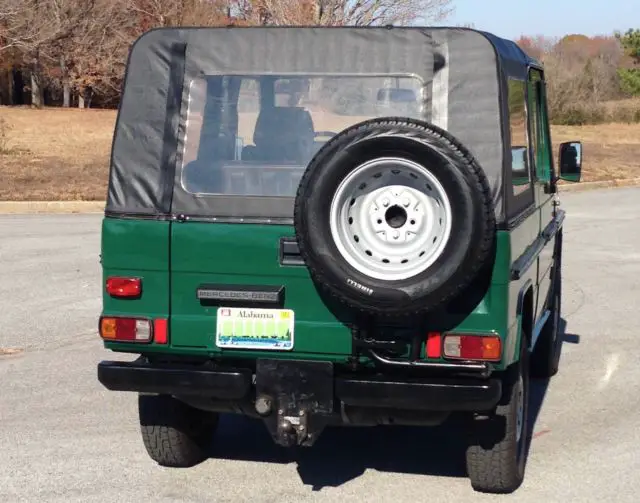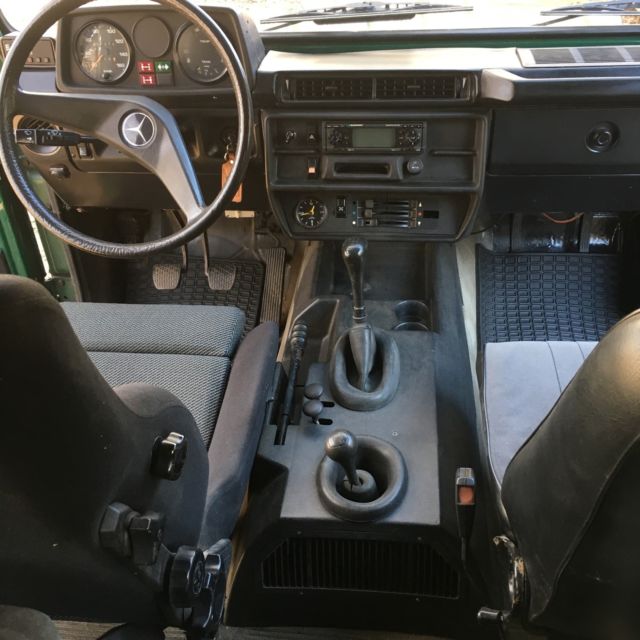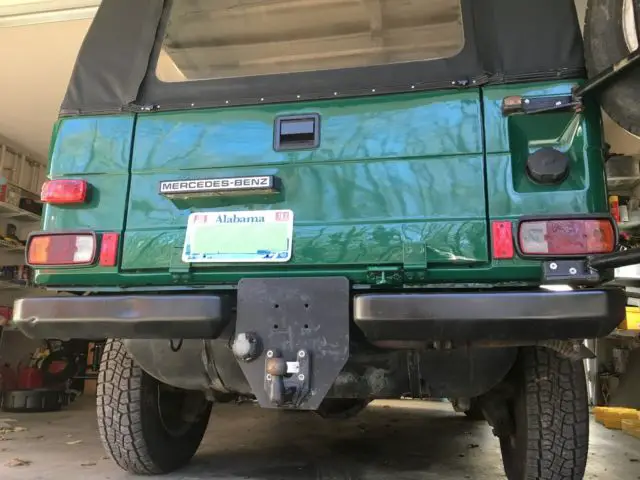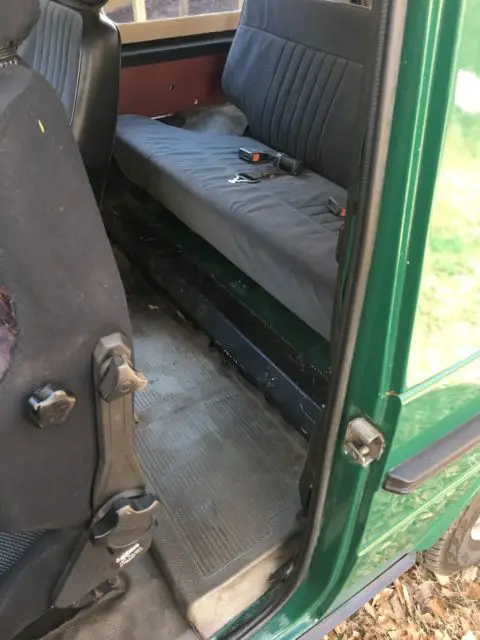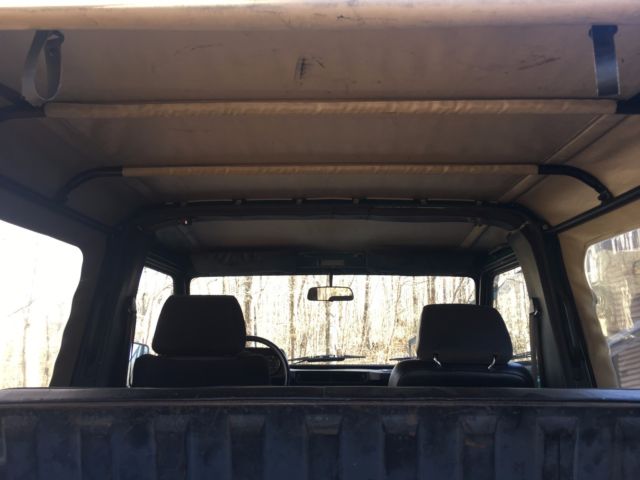1981 Mercedes-Benz Geländewagen 300GD Cabriolet
| Condition: | Used |
| Make: | Mercedes-Benz |
| Model: | G-Class |
| SubModel: | 300GD |
| Type: | Convertible |
| Year: | 1981 |
| VIN: | 00000000000000000 |
| Color: | Green |
| Engine: | 3.0 turbodiesel |
| Cylinders: | 5 |
| Fuel: | Diesel |
| Transmission: | Manual |
| Drive type: | 4WD |
| Interior color: | Gray |
| Vehicle Title: | Clear |
| Item location: | Athens, Alabama, United States |
| Extras |
|
4-Wheel Drive, Convertible |
| Listed by | Private seller |
Description of 1981 Mercedes-Benz G-Class |
|
Hello and thanks for checking out my G-wagen listing. In addition to the pictures here, I've posted a couple of driving videos at the following links: Off-Road Street Up for auction is my 1981 Mercedes Geländewagen, model 300GD. I’ve had it for just over ten years. It was imported in 2006 by Eurotruck Importers in Georgia. I bought it from them in December of that year. So I know the car well, and I can say that it’s as reliable as a hammer, and not much more complicated. It’s a cool vehicle, but I’ve never really used it as much as I thought I would, so it’s time to let it go. I’d like to clarify up front that this is not a project vehicle with a lot of deferred maintenance, as is so often the case with older vehicles like this. It won’t ever be like brand new again, but it’s quite useable. People often lose interest in maintaining their classic car and eventually decide to just sell it, rather than deal with the problems. That isn’t the situation here. I’ve done my due diligence in maintaining this vehicle. But it’s also one of several vehicles that I have, and the time has come to do some downsizing. If you’re new to the W460 (1979-89) G-wagen, it was just a heavy-duty, no-frills 4WD that was a true Sport Utility Vehicle. After all, the G-class was originally conceived as a military vehicle and there are indeed military variants used by various fighting forces around the world. But if you’re not looking for an off-roader, I doubt you’d be very satisfied with this vehicle purely as a road car. You probably won'tever see a celebrity driving one of these. On the other hand, if you’re looking for an inexpensive but solid G-wagen that you can actually drive off-road without worrying too much about putting a scratch on it, here you go. With its extremely heavy-duty, fully-boxed ladder frame, solid axles with selectable locking differentials, a low first gear, factory 4.88:1 differentials and torquey diesel engine, it goes off road like a 4WD tractor. It’s a completely mechanical vehicle with no electronics or powered accessories. So it really is extremely simple, with very little to go wrong, compared to any modern vehicle. That becomes important when dealing with vehicles of this age. However, this one does have some nice upgrades. The original normally-aspirated OM617 diesel engine was swapped out for an OM617.95 turbo-diesel. This is possibly the most reliable engine Mercedes ever built. And having recently replaced the glow plugs in my ’95 E300 sedan, which was a nightmare, I’ve just gained a fresh appreciation for how straightforward the OM617 is to work on. The turbo version of the OM617 bumped the power output from the original 88 HP in the G-wagen application to around 125 HP. It has a Mercedes polyethylene fuel tank, which will never rust. It has a (larger) brake booster from a later model G, which makes the brakes much easier to use. The car also has a König driver’s seat, which is a huge improvement over the OEM seat. It’s firm, but very supportive and adjustable, with deep bolsters. The stock seat will be included, but I doubt you’d ever want to use it. it’s like sitting on a big marshmallow compared to the König. There is one minor issue with the König seat, which is that the outside upper bolster on the seat back had a weird failure of the fabric covering — see the picture. This has just happened within the last year or so. It wasn’t really from wear, but more like a small section of the fabric just randomly failed. Otherwise the seat is excellent and has always been one of my favorite features of this vehicle. Finally, the G has a Webasto engine block heater. This heater is plumbed into the main fuel tank, so it burns the same diesel as the engine itself. Its job is to heat and circulate the coolant throughout the engine block to pre-warm it prior to startup, making cold starts easier in extremely low temperatures. Here in the southern U.S., it really has no use, but in a cold climate, it would make a nice wintertime accessory. Unfortunately, though it was working perfectly when I first got the vehicle, it has since stopped working. I’ve read that these things need to be exercised regularly to keep them in good status. I forgot to do that in the last few years. Work that I’ve done over the years included rebuilding the front axle (replace seals and bearings and clean/repack steering knuckles), replacing the heater core/blower, replacing all hydraulic and fuel lines with Federal Hill “Cunifer” alloy tubing (never rusts), and rebuilding the master cylinders for the hydraulic differential locks. I’ve done other little miscellaneous fixes or improvements over the years, in addition to the routine maintenance tasks like oil changes, fuel filters, valve adjustment, etc. One problem that I haven’t been able to fix is that water is able to leak around the tops of the doors and ends up on the floor at the door sills. The G has always had covered storage, but I discovered this when washing it, or on the occasion that it happened to get heavily rained on. I replaced the gaskets on the door openings of the body, but apparently that wasn’t the issue. It just made the doors a little harder to latch due to the fatter rubber of the new gaskets. So I guess something is not perfectly flat or square somewhere, but I haven’t been able to detect the problem by visual inspection. Other things that aren’t working include the backup lights and the stereo. I believe the stereo actually does work, but I don’t think I bothered to reconnect the head unit after I did the heater core replacement years ago, for two reasons. One is that the system’s 6x9 speakers had been installed in the lower doors, which prevented the windows from being fully lowered. I didn’t like that, so I removed the speakers. I knew I wouldn’t miss them, because having a stereo in this vehicle wasn’t important to me anyway. Being a soft top SUV from the early 80s, there’s a lot of road noise on the highway, and for off-road use, I don’t need a stereo. Regarding rust: having been used in Europe for 25 years, there was no way this car could be completely rust free, but this one is actually not bad at all. The chassis has only minimal light surface rust in places. You can see some slight rust on the right frame rail, for example, in spots where the frame probably came in contact with rocks. There used to be rust damage on the upper mounts for the rear shocks, but I obtained the factory replacement shock mounts and had that professionally repaired. (The original mounts hadn’t failed, but I knew that area was going to need attention eventually.) As for rust on the body, there used to be rust in the rear sill panel under the tailgate. That and the area around the tail lights are the common problem areas on these vehicles, and this one had rust damage in the sill panel. In the pictures, this is the narrow panel directly below the tailgate, which the tailgate hinges fasten to. Again I was able to get a factory Mercedes replacement panel through Eurotruck, and had that problem fixed, along with the shock mounts, at a local body shop in Huntsville. They did a great job and the rear area looks as good as new now. The only other rust I’ve found bubbling up on the painted surfaces of the body is light rust along the door bottoms (picture). As I mentioned, wetness is an issue there. Also, there’s a part of the undercarriage which has the same rusted spot on both sides of the vehicle. I’ve included these spots in the pictures. The passenger side is the worse one. On the driver’s side it seems to be just surface rust. That part of the floor pan presents a large vertical face to the elements, and due to its outboard location, I think it probably gets trailing spray from the front wheels. I can imagine snow and slush being deposited there when it was in Europe. The Pirelli tires are fairly new with probably still under 1000 miles on them. The rear springs are also new - I had a broken one, and they come in pairs, so both were replaced. Mileage on the G is unknown, as it’s only a five-digit odometer and it surely must have rolled over at least once before I got it. Note that this was a gray-market vehicle imported to the U.S. under the 25-year rule, meaning that it didn’t require modification of any of its European running gear to U.S. spec in order to be road-legal here. So the speedometer and odometer are still counting kilometers rather than miles. Therefore the odometer rolls over at 100,000 km, or 62,000 miles. That seems crazy now, but back in 1981, five-digit odometers were not uncommon. With vehicles of this age, condition is more important than mileage anyway. Thanks for looking, and feel free to let me know if you have any questions. The VIN is 46031217014122. Ebay doesn't accept that value in the VIN field because the VIN isn't a 17-character U.S. VIN. |
 Home
Home Contact us
Contact us NEWEST CARS
NEWEST CARS SELL YOUR CAR
SELL YOUR CAR FAQ
FAQ



